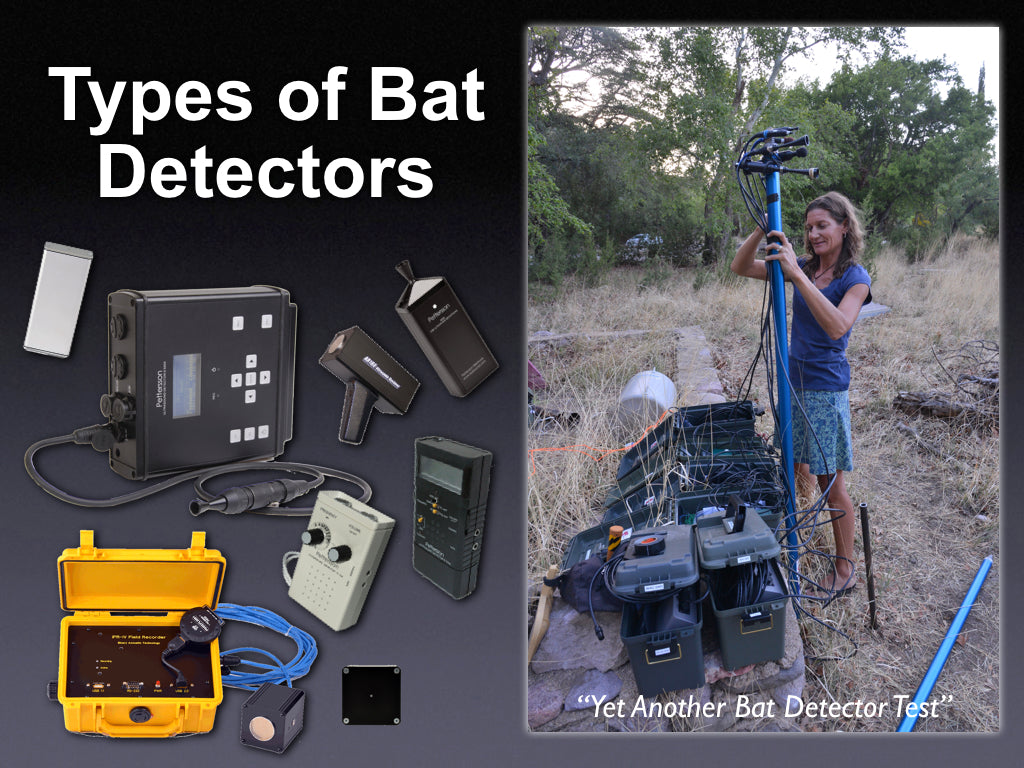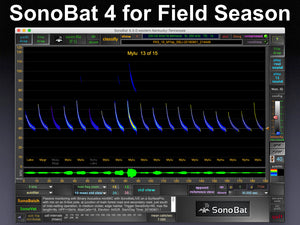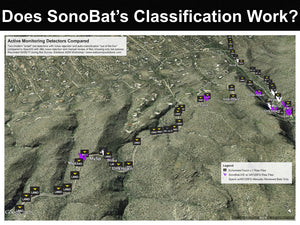Types of Bat Detectors


The Heterodyne Class
Heterodyning (HET): The HET bat detector is the lowest-tech bat detector option, and as such its outputs are very basic. It produces an audible signal. This signal can be broadcast thru a speaker, fed thru headphones to allow individual listening and thus improved perception of sound.
Setting a HET detector to 40kHz makes echolocation calls between about 35-45kHz audible, in real time. Most bat calls are broad-band, sweeping thru many frequencies over time, so only a portion of the call transformed by the HET system is re-played.
Depending upon the dialed frequency of the detector and the characteristics of the bat call (i.e., the duration of the call that is within the dialed frequency range), the tonal output of the detector will vary, sometimes producing a "chirping" sound (indicating a narrow-band, longer call) or a "ticking" sound (for a broad-band, shorter call). With practice, it is possible to identify some species based upon the dialed frequency and the detector output, especially in areas with limited species diversity.
Because only a small portion of the original high-frequency sound of the bat is transformed, signal-processing to determine key identifying call parameters is not possible. There is no way to get at information about how the signal frequency, or amplitude, changes over time, or anything else about the call structure (e.g., maxF, minF, slope, harmonics, etc.)
Among the advantages of heterodyne detectors are that they are inexpensive, rugged, and provide “good” signal-to-noise ratio which makes them highly sensitive to incoming signals. HET detectors are perfect for using in “real time” when the bat can be observed in flight while the signal is being transformed, giving investigators simultaneous visual and auditory clues to bat behavior and ID. They can also be hooked up to a recording device and used passively, allowing multiple units to be deployed concurrently in different habitats, to measure bat occupancy or behavior across spatiotemporal scales.

The main disadvantage to heterodyning is that the detector only selects a very narrow bandwidth of the original call to play back. It does not preserve any information about the original call’s “structure” e.g., duration, absolute frequencies, or the frequency-time course. It must be manually dialed to respond to the frequency of interest. This narrow sampling window may lead to under-representations of certain species in survey work because bats calling at frequencies outside the dialed frequency will be missed.
Best uses for heterodyne detectors include deployment for “active” surveys when the bat that is detected can be spot-lighted at the same time for cues to identification based on the audible rendition of the call and the morphology of the bat in flight. There are limited opportunities to identify bats based on the heterodyne output alone . . . except in areas of depauperate bat faunas where the different bat species produce calls that exhibit significant difference in duration and/or minimum frequency. That being said, heterodyne bat detectors have been used to great effect in the U.K. for identifying different morphologically indistinct pipistrelle bats which have very different echolocation call types.

Frequency Division Class
Frequency division (FD): FD detectors use a broadband conversion, transforming the entire bat call in real-time. The original high frequency call is converted to a "square" wave and divided by a user-selected ratio (usually 4, 8, 10, 16, or 32). The detector counts how many times the original high-frequency sound wave cycles from negative to positive, producing an output signal for every 4, 8, 10, 16, or 32 “zero-crossings.” This results in an output that is 1/4th, 1/8th, 1/10th, 1/16th, or 1/32nd of the input frequency.
The user-selected division ratio helps provide efficient processing. Low frequency calls are better represented at low division ratios, and high frequency calls should be recorded at higher division ratios. For most North American bat species a division ratio of 8 or 16 is used. For many of the low-frequency bats, especially big-free tailed bats, spotted bats, and lappet-browed bats out west, a division ration of 4 or 8 is better.

Though FD detectors are often less sensitive than other units, they are quite capable of producing accurate representations of the bat call, including important information about the shape, slope, and characteristic frequency. This is helpful because these parameters are often used in species identification.
Because the output of a FD detector is so much lower in frequency than the original signal, the sampling rate required to digitize the signal is low enough that a precise representation of the call’s duration and frequency-time course can be digitized and displayed in real-time. And, because the detector uses a “broadband” conversion process, the entire bat call is recorded, eliminating the need to “tune” the detector to a target frequency. This allows for real-time “active” monitoring where the bat’s morphology, flight-style, and behavior can be observed and associated with the incoming signal, which can aid greatly in species identification. Files generated by FD analysis are small in size, only 4-8 kB, therefore passive monitoring is extremely efficient and large numbers of files over a long duration can be recorded without taxing digital storage systems.
The drawbacks of FD bat detectors are that they are less sensitive. They cannot display a full spectrum of call parameters, such as: multiple harmonics (they will only play the signal with the most energy), and information about the amplitude or strength of the incoming signal cannot be displayed. Moreover, because the detector will only pick up the signal with the most energy (the loudest incoming signal) it will often over-represent bats with high-intensity echolocation calls when used in survey work. Or, preferentially switch to recording bats with intense calls that enter into the same airspace where quieter bats may be flying.
FD bat detectors are versatile enough that they can be used for either Active or Passive surveys. AnaBat detectors are useful for determining species ID in all but the most cryptic species. They are among the best detectors for mobile transects due to the realtime rendering of echolocation calls. And they can be used to record “voucher calls” for call libraries during hand-release efforts.

Direct Recording Class
Direct Recording (DR) detectors generally have no audio output. They convert the incoming high-frequency call directly to a digital format and store thru USB port (AR125), onto CF card (D500x) or SD-HC card (SM series).
DR devices can record full spectrum sound, some as fast as 768,000 samples per second. They may also be the simpler FD technology. But what makes a device fall into this category is that it can continuously record without missing sound until the storage media fills or the power (or something else) physically fails. Because each full spectrum audio-file is a friendly WAV format, signal analysis is possible thru popular software programs: Bat Sound, Scan'R, Kaleidoscope, and SonoBat which will display and analyze any bat calls recorded in WAV format.

DR units are capable of preserving all spectral components (amplitude, harmonics, signal strength, etc.) of the original, incoming bat call. The microphone is very sensitive, and provides a broad band conversion of the entire frequency time scale for bat echolocation calls.It does not need to be manually “tuned” to record calls. Generally these devices do not have live views of bat calls to save power. DR detectors output large WAV files that can be up to ~5 MB in size for a 5 second recording.
DR units are excellent for passive surveys, especially long-term surveys, because the microphone/receiver and recording media is usually fully integrated. When recording in full-spectrum or FD (or both) they are capable of recording tens of thousands of call files, which really necessitate some sort of post processing automated classification solution to aid the researcher in wading through to the best recordings in the dataset. They are also easy to deploy during mobile, passive transects. We suggest recording in full spectrum for archival purposes and to best future proof data, as full spectrum recordings can always be downsampled to FD type recordings, but FD files can never be converted to full spectrum.
What is Time Expansion (TE)?
Today, TE is used more as an active monitoring tool in the field, or later when sitting with analysis software. However in the early days of full spectrum bat recording, it was a viable method for field recording. While not often used in this way today, it should be mentioned for sake of clarity
Time Expansion (TE) units: Notably the Pettersson D240x and D1000x, provide various outputs and opportunities for signal recording and analysis. The real-time HET signal of these devices can be played thru the on-board speaker, or broadcast thru headphones.
These detectors also record a "time-expanded" signal which is lower in frequency and 10x slower in time than the original input. This has two very important functions; first in it's heyday this allowed relatively slow computers to sample the entire spectral components of the incoming sound and digitize the entire time/frequency - amplitude/frequency content of the sound. This includes the recording of harmonics. Newer, faster DR detectors have reduced the need to use TE for long term recording projects. Even USB microphones (Pettersson M500 and almost any microphone from Binary Acoustics) simply connect to smartphones and tablets that have no problem keeping up with the high sampling rate required to record bat calls for active recording as well.
But the second function of TE sound is still -very- relevant today, particularly when manually vetting prerecorded bat calls. When the sounds is played 10x slower than real time, what was first perceived as fairly indistinct rapid fire clicks become "bat songs" of sorts with rich tonal qualities and inflections. Multiple bats can be discerned as well as even some behavior characteristics. This is why good bat software analysis packages have an ability to play sound for you in TE.
The advantage of time-expansion over both FD and HET is that TE detectors are capable of preserving all spectral components (amplitude, harmonics, signal strength, etc.) of the original, incoming bat call. The microphone is very sensitive, and provides a broad band conversion of the entire frequency time scale for bat echolocation calls. It does not need to be manually “tuned” to record calls. The sound file is saved in a small buffer built into the device and must be replayed into a recording device 10x slower than real time (hence, TE). This allows calls to be analyzed by sound analysis programs, including BatSound, SonoBat, AviSoft, etc.
Because the detector samples the incoming call and then plays it back at a rate of 10 times slower, the effective sampling time is reduced to 10% of real-time. (Leaving 90% of the night effectively un-sampled.) While the current call is being stored and/or played back, other incoming calls may be missed, thus under-representing bat diversity or abundance. This can become especially troublesome in noisy environments where random high-frequency sounds (i.e., insect noise) could trigger the detector often, rendering it unresponsive to actual bat calls
In field trials with these units in side-by-side tests with AnaBat and the direct recording detectors indicate that when approximately 100 calls are recorded over a 2 hour period in AZ and NM, between 2-5 calls would be missed on the TE detectors due to the 17-second lag between expanding and saving a call. That is, in most situations, bat calls do not come in in less than 17 second intervals very frequently, so functionally, very few bat calls are actually missed.
- John Chenger






